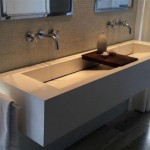Bathroom Sink Shapes: A Comprehensive Guide
The bathroom sink, a functional necessity, has evolved significantly from its purely utilitarian origins. Today, it stands as a key element in bathroom design, influencing both the aesthetic appeal and the practicality of the space. One of the most crucial factors in selecting a bathroom sink is its shape. The choice of sink shape can dramatically impact the overall style, functionality, and spatial efficiency of the bathroom. A thorough understanding of the available shapes, their characteristics, and suitability for different bathroom layouts is essential for homeowners and designers alike. This article provides a comprehensive overview of various bathroom sink shapes, detailing their features and considerations for selection.
Understanding the Impact of Sink Shape
The shape of a bathroom sink is not merely an aesthetic consideration; it directly impacts several aspects of the bathroom experience. Firstly, the shape affects the available counter space. A wide, circular sink will naturally occupy more surface area than a narrow, rectangular one. Secondly, the shape influences the depth and volume of the sink basin. A deeper bowl is better suited for tasks involving larger quantities of water, while a shallower basin might be more appropriate for hand washing. Thirdly, the shape contributes to the overall style of the bathroom. A sleek, square sink complements a modern design, whereas a curved, oval sink might be more fitting for a traditional aesthetic. Therefore, careful consideration of these factors is paramount when choosing a sink shape.
Furthermore, the shape of the sink can impact the ease of cleaning and maintenance. Sinks with intricate designs or numerous corners may be more difficult to clean than those with simpler, smoother shapes. The material of the sink also plays a role in cleaning ease, but the shape is a significant factor nonetheless. Finally, the shape of the sink should complement the other fixtures and fittings in the bathroom, such as the faucet and countertop. A harmonious combination of these elements contributes to a cohesive and aesthetically pleasing bathroom design.
Common Bathroom Sink Shapes and Their Characteristics
The market offers a diverse range of bathroom sink shapes, each with unique features and applications. Understanding these shapes is crucial for making an informed decision that aligns with the homeowner's needs and preferences.
Round Sinks
Round sinks are characterized by their circular shape, offering a classic and versatile appeal. They are often chosen for their smooth, organic curves, which contribute to a softer, more inviting ambiance. Round sinks are available in various sizes, making them suitable for both small and large bathrooms. They can be mounted in various ways, including vessel, undermount, and drop-in configurations. Round sinks are generally easy to clean due to their lack of sharp corners, although the curved surface can sometimes accumulate soap residue. The simplicity of the round shape makes it compatible with a wide range of bathroom styles, from traditional to contemporary.
A significant advantage of round sinks is their space-saving potential, particularly in smaller bathrooms. A smaller, round vessel sink, for example, can maximize counter space while still providing adequate functionality. However, larger round sinks can occupy a considerable amount of counter space, so careful measurement and planning are essential. The faucet selection for round sinks should also be considered carefully, as the spout should be long enough to reach the center of the bowl without causing splashing.
Oval Sinks
Oval sinks are similar to round sinks but feature an elongated shape. This shape provides a slightly larger basin area while maintaining the soft, curved aesthetic. Oval sinks are a popular choice for bathrooms of all sizes and styles, offering a balance of functionality and visual appeal. Like round sinks, they are relatively easy to clean and can be mounted in various ways. The elongated shape of oval sinks can be particularly advantageous in narrow bathrooms, as it allows for a more streamlined installation. The wider basin can also be more comfortable for tasks such as shaving or washing one's face.
The elongated shape of the oval sink can also impact the placement of the faucet. It’s generally recommended to use a faucet with a longer spout to ensure that the water reaches the center of the bowl. Oval sinks can complement both traditional and modern bathroom designs, depending on the material and finish chosen. A ceramic oval sink with a classic faucet can create a timeless look, while a sleek, stainless steel oval sink can enhance a contemporary aesthetic.
Square Sinks
Square sinks are defined by their sharp angles and clean lines, making them a popular choice for modern and contemporary bathroom designs. They offer a bold, geometric aesthetic that can add a touch of sophistication to the bathroom. Square sinks are available in various sizes, from compact models suitable for small spaces to larger, more dramatic designs. They can be mounted as vessel sinks, undermount sinks, or drop-in sinks. However, cleaning square sinks can be more challenging due to the sharp corners, which can accumulate dirt and grime.
The angular shape of square sinks can also impact the perceived space in the bathroom. The strong lines can create a sense of order and structure, making the bathroom feel more organized. However, the sharp edges can also be a potential safety hazard, especially for young children. For this reason, it is essential to consider the needs and preferences of all users when selecting a square sink. The faucet selection for square sinks should also complement the angular design; a square or rectangular faucet with clean lines is generally the best choice.
Rectangular Sinks
Rectangular sinks are similar to square sinks, but they are longer than they are wide. This shape provides a generous basin area, making them ideal for bathrooms where functionality is a priority. Rectangular sinks are often chosen for master bathrooms or bathrooms used by multiple individuals. They can be mounted as vessel sinks, undermount sinks, or drop-in sinks. Like square sinks, cleaning rectangular sinks can be more challenging due to the sharp corners. However, the larger basin area can be particularly beneficial for tasks involving larger quantities of water.
The elongated shape of rectangular sinks can also impact the overall layout of the bathroom. They can be used to create a sense of length and continuity, making the bathroom feel more spacious. Rectangular sinks are often paired with long, narrow countertops to maximize counter space. The faucet selection for rectangular sinks should complement the elongated design; a rectangular faucet with a long spout is generally the best choice. Rectangular sinks are a versatile option that can be adapted to various bathroom styles, from modern to transitional.
Vessel Sinks
Vessel sinks, also known as above-counter sinks, are characterized by their installation method: they sit on top of the countertop rather than being recessed into it. This distinctive design creates a focal point in the bathroom and adds a touch of drama. Vessel sinks are available in a wide range of shapes, including round, oval, square, and rectangular. They can be made from various materials, such as ceramic, glass, stone, and metal. The raised profile of vessel sinks can make them more accessible for individuals with mobility issues.
The installation of vessel sinks requires careful consideration of the countertop height. The combined height of the countertop and the sink rim should be within a comfortable range for the user. The faucet selection for vessel sinks is also crucial; a tall faucet with a long spout is necessary to reach the basin properly. Vessel sinks can be a stylish addition to any bathroom, but they may not be the best choice for small spaces, as they can take up a significant amount of counter space. The exposed edges of vessel sinks can also be more susceptible to chipping and damage.
Corner Sinks
Corner sinks are designed to fit into the corner of a bathroom, making them an excellent choice for small or awkwardly shaped spaces. They maximize space efficiency by utilizing otherwise unused areas. Corner sinks are typically triangular or angled in shape, and they can be mounted as wall-mounted sinks or pedestal sinks. They are often chosen for powder rooms or guest bathrooms where space is limited. While corner sinks can be a practical solution for small bathrooms, they may not provide as much basin area as other sink shapes.
The installation of corner sinks requires careful planning to ensure that the plumbing is properly routed. The faucet selection for corner sinks should also complement the angled design; a faucet with a swivel spout can be particularly useful. Corner sinks can be a functional and stylish addition to small bathrooms, but they may not be suitable for larger bathrooms where space is not a constraint. The triangular shape of corner sinks can also impact the overall aesthetic of the bathroom, adding a unique and unexpected element.
Selecting the Right Sink Shape for Your Bathroom
Choosing the right bathroom sink shape involves careful consideration of several factors, including bathroom size, style, functionality requirements, and personal preferences. The size of the bathroom is a primary consideration, as it will determine the maximum size and shape of the sink that can be accommodated. In small bathrooms, space-saving options such as round, oval, or corner sinks are often the best choice. In larger bathrooms, there is more flexibility to choose larger, more dramatic sink shapes such as rectangular or vessel sinks.
The style of the bathroom is another important consideration. The sink shape should complement the overall aesthetic; square and rectangular sinks are well-suited for modern bathrooms, while round and oval sinks are better suited for traditional bathrooms. Vessel sinks can add a touch of drama to any bathroom, but they should be chosen carefully to ensure that they complement the other fixtures and fittings. The functionality requirements of the bathroom should also be taken into account. If the bathroom is used for tasks involving larger quantities of water, a larger basin area is desirable. If the bathroom is primarily used for hand washing, a smaller basin area may be sufficient.
Finally, personal preferences play a significant role in the selection process. The homeowner should choose a sink shape that they find aesthetically pleasing and that meets their individual needs and preferences. It is helpful to visit showrooms and browse online catalogs to get a sense of the available options. Consulting with a bathroom designer can also be beneficial, as they can provide expert advice and guidance on selecting the right sink shape for your bathroom. By carefully considering these factors, it is possible to choose a bathroom sink shape that is both functional and aesthetically pleasing, enhancing the overall design and functionality of the bathroom.

Bathroom Sink Guide Fix

Oval Vs Square Bathroom Sinks

Types Of Bathroom Sinks The Home Depot

Basin Guide Adp

Classic Oval Shape Bathroom Vanity Sink Diffe Sizes Professional Sanitary Ware Manufacturer From China Sunrex

Artificial Special Shape Cast Stone Corian Solid Surface Bathroom Sink Above Counter Wash Basin For China Sanitary Ware Made In Com

Deervalley Ally 26 5 8 In Tall Modern U Shape White Vitreous China Pedestal Bathroom Sink With Overflow Dv 1p525 The Home Depot

Carrara White Marble Flower Shape Sink Bowl Polished Villohome Com

Modern Bathroom Sink Porcelain Oval Shape Drop In With Pop Up Drain Clearhalo

White Artificial Oval Shape Cast Stone Corian Solid Surface Bathroom Sink Above Counter Wash Basin For China Sanitary Ware Made In Com
Related Posts







